Best LED Grow Lights for the Money – 2022 Reviews and Buying Guide
Choosing the best LED grow lights for the money can be a long and overwhelming process. I’m here to help!
There is no one size fits all grow light, so getting the right one will depend on you. The perfect one for you will come down to many factors such as the size of your project, your grow space, the budget you have, the running costs and the amount of effort you’re willing to put in.
The following guide will help you narrow down your options and give you an idea of what to look for and which LED grow light will be the best selection for you.
Here is what we will cover:
The comparison table below will present you the highest quality LED grow lights on the market, along with their most important specs.
This will give you a broad idea of the size of LED grow light you need for your individual project whilst also helping you to navigate the article quickly.
1. Top 15 – Best LED Grow Lights Comparison Table
 | Max Coverage: 6 x 4.5 feet | Read Review | |
 | Max Coverage: 6 x 3.75 feet | Read Review | |
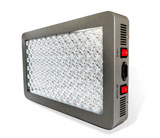 | Max Coverage:4.5 x 4 feet | Read Review | |
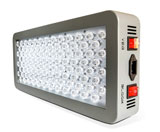 | Max Coverage:4.5 x 3.8 feet | Our Review | |
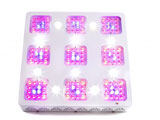 | Max Coverage:4.5 x 4.5 feet | Our Review | |
 | Max Coverage:3 x 3 feet | Our Review | |
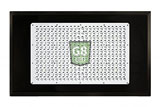 | Max Coverage:4 x 6 feet | Our Review | |
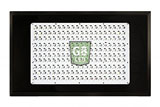 | Max Coverage:4 x 5 feet | Our Review | |
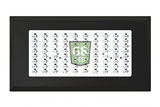 | Max Coverage:3 x 2 feet | Our Review | |
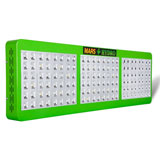 | Max Coverage:4.5 x 2.5 feet | Our Review | |
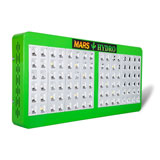 | Max Coverage:3.5 x 2 feet | Our Review | |
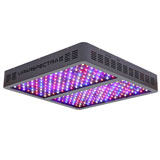 | Max Coverage:5 x 5 feet | Our Review | |
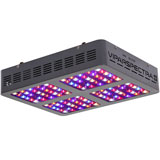 | Max Coverage:4 x 4 feet | Our Review | |
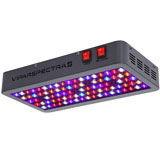 | Max Coverage:3.5 x 3.5 feet | Our Review | |
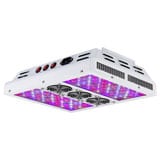 | Max Coverage:4 x 4 feet | Our Review |
2. The 15 Best LED Grow Lights for the Money
2.1. Advanced Platinum Series P900 – Editors Choice
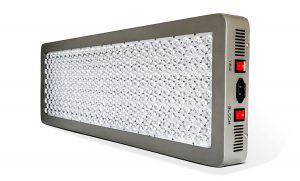
We’re kicking off our list with a serious piece of equipment for serious growers looking to raise up to 24 plants at a time. The Advanced Platinum Series P900 is the LED’s answer to a 1000W HID. It’s comprised of three pieces that each provide the equivalent of 300W. The actual consumption is a mere 515W which is incredibly efficient.
The P900 features a two-way switcher for veg and bloom stages which can be both switched on for a 100% panel power. At 100% the spectral frequency shifts to a pink/ red output for maximizing the bloom. In addition, the P900 is fitted with whisper quiet fans and an aluminum cooling sink to keep excess heat down. The Platinum series offers a 5-year warranty on the LED’s which have a lifespan of 100,000 hours. A sound investment.
Read our in-depth Advanced Platinum Series P900 Review
2.2. Advanced Platinum Series P600
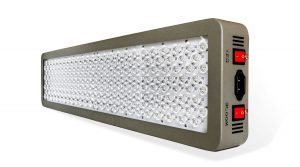 The P600 is the P900’s little brother. It offers similar features to the P900 like the focusing lens, which allows for refined penetration as well as a two-way light switcher, for the vegetative and flowering stages. At a height of 18 inches the P600 covers 6 by 3.75 foot. It comes with a full spectrum light focus providing 100% of usable light for your crops. As with all products from the Platinum series you are looking at a lifespan of 100,000. The P600 will provide a good yield for medium projects of roughly 6 to 9 plants.
The P600 is the P900’s little brother. It offers similar features to the P900 like the focusing lens, which allows for refined penetration as well as a two-way light switcher, for the vegetative and flowering stages. At a height of 18 inches the P600 covers 6 by 3.75 foot. It comes with a full spectrum light focus providing 100% of usable light for your crops. As with all products from the Platinum series you are looking at a lifespan of 100,000. The P600 will provide a good yield for medium projects of roughly 6 to 9 plants.
Read our in-depth Advanced Platinum Series P600 Review
2.3. Advanced Platinum Series P450
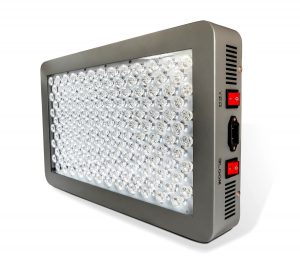 The P450 is the go to LED grow light for those who are planning projects of different shapes and sizes. It covers an impressive 4 by 4.5 feet which is small enough for a grow tent, but also large enough for growing up to 10 plants. The P450 provides an equivalent light of 600W whilst consuming a tiny 255W. You get all the Platinum Series features too: the double switch for 100% light during the bloom, a super-quiet cooling system, 90-degree focusing lens for penetrating the canopy and a 5-year guarantee on its 50,000-hour minimum lifespan. Like the other Platinum Series, this one too offers a maximum amount of bloom on a minimum amount of electricity.
The P450 is the go to LED grow light for those who are planning projects of different shapes and sizes. It covers an impressive 4 by 4.5 feet which is small enough for a grow tent, but also large enough for growing up to 10 plants. The P450 provides an equivalent light of 600W whilst consuming a tiny 255W. You get all the Platinum Series features too: the double switch for 100% light during the bloom, a super-quiet cooling system, 90-degree focusing lens for penetrating the canopy and a 5-year guarantee on its 50,000-hour minimum lifespan. Like the other Platinum Series, this one too offers a maximum amount of bloom on a minimum amount of electricity.
Read our in-depth Advanced Platinum Series P450 Review
2.4. Advanced Platinum Series P300
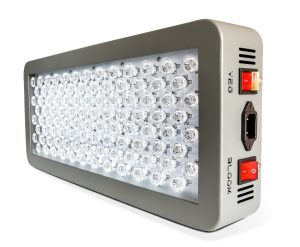 Like the P900 and P600, the P300 has a built in cooler which means this LED is ready to go straight from the box. But unlike, the other two, there are no additional costs to consider like ventilation. Super efficient with a coverage of 4.5 by 3.8 foot the Advanced Platinum Series P300 is ideal for small scale, 3 by 2 foot grow tents. Optimal coverage is around 2 to 6 plants. You don’t have to compromise on yield either as the P300 offers the same two-way stage switch, 100% maximum pink band output and a 5-year warranty for its 100,000-hour lifespan.
Like the P900 and P600, the P300 has a built in cooler which means this LED is ready to go straight from the box. But unlike, the other two, there are no additional costs to consider like ventilation. Super efficient with a coverage of 4.5 by 3.8 foot the Advanced Platinum Series P300 is ideal for small scale, 3 by 2 foot grow tents. Optimal coverage is around 2 to 6 plants. You don’t have to compromise on yield either as the P300 offers the same two-way stage switch, 100% maximum pink band output and a 5-year warranty for its 100,000-hour lifespan.
Read our in-depth Advanced Platinum Series P300 Review
2.5. AdvancedLED lights Series XML 350
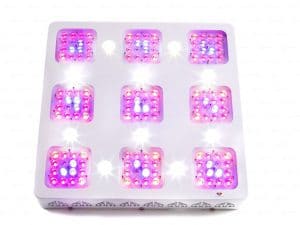 The XML 350 began life in AdvanceLED’s very own research centre. The XML 350 cutting edge technology is comprised of 10W single chip LED’s that have a lifespan of 50,000 hours, Computer designed 90-degree lenses and 11+ PAR wavelengths. The coverage area is 4.5 by 4.5 feet which is enough for small production grow tents as well as medium sized projects.
The XML 350 began life in AdvanceLED’s very own research centre. The XML 350 cutting edge technology is comprised of 10W single chip LED’s that have a lifespan of 50,000 hours, Computer designed 90-degree lenses and 11+ PAR wavelengths. The coverage area is 4.5 by 4.5 feet which is enough for small production grow tents as well as medium sized projects.
The XML offers an equivalent of 600W output so we’re talking about a good yield for 4-8 plants. It has bespoke dimmer switches for each growing stage which change color frequencies to suit the type of light your plants need. I especially like the daisy chain power system, allowing you to hook multiple XML’s together as your expertise, and projects grow. The only issue for me is that these LED’s can be too strong, meaning you have to take care not to burn your plants.
Read our in-depth AdvancedLED lights Series XML 350 Review
2.6. California Lightworks 440W LED Grow Light
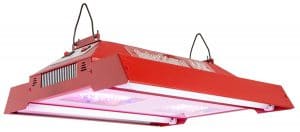
In terms of thinking outside the box, the California Lightworks team deserve an A+ for their 440W grow light. Featuring a unique, inbuilt UVB fluorescent bulb to maximize yield during the flowering stage the 440 can cover 3 by 3 foot for bloom, and 6 by 6 for veg. Coverage wise with the California Lightworks, you’re looking at a small grow tent operation of 3 to 6 plants. It’s in the upper half of the budget but, given the dual bulb system and its 50,000-hour lifespan, the California Lightworks 440W represents great value for money.
Read our in-depth California Lightworks 440W LED Grow Light Review
2.7. G8LED 900 Watt MEGA LED Grow Light
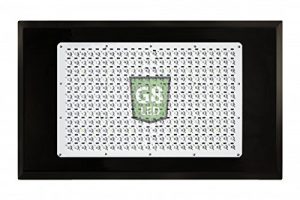 The G8LED offers the astonishing power of a 1200W HPS using just 540 Watts of power. I also love the fact that the 3W LED’s produces less heat thereby reducing the chances of burning your plants. It’s an efficient, low-maintenance LED that can handle huge projects covering up to 24 square foot; that’s comfortably 20 plants at a time. In addition, the G8LED has two 90W red flower boosters that can be switched on during the bloom stage for maximum yield. It’s a big outlay, but with a 3-year warranty and a 50,000-hour lifespan, it’s worth it.
The G8LED offers the astonishing power of a 1200W HPS using just 540 Watts of power. I also love the fact that the 3W LED’s produces less heat thereby reducing the chances of burning your plants. It’s an efficient, low-maintenance LED that can handle huge projects covering up to 24 square foot; that’s comfortably 20 plants at a time. In addition, the G8LED has two 90W red flower boosters that can be switched on during the bloom stage for maximum yield. It’s a big outlay, but with a 3-year warranty and a 50,000-hour lifespan, it’s worth it.
Read our in-depth G8LED 900 Watt MEGA LED Grow Light Review
2.8. G8LED 600 Watt MEGA LED Grow Light
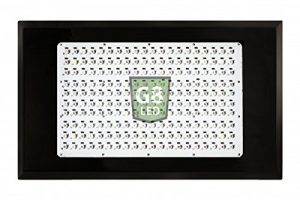 G8LED spent eight years developing this series for maximum efficiency without compromising on yield. What makes these grow lights so efficient is the color spectrum can be switched to red booster light-bands that encourage photosynthesis during the bloom stages. It means you won’t be wasting electricity on bands that aren’t be optimizing your yield. Provides coverage up to 18 square feet the G8LED has a 50,000-hour lifespan and is perfect for medium size operations. A top performer for growing around 18 plants at a time.
G8LED spent eight years developing this series for maximum efficiency without compromising on yield. What makes these grow lights so efficient is the color spectrum can be switched to red booster light-bands that encourage photosynthesis during the bloom stages. It means you won’t be wasting electricity on bands that aren’t be optimizing your yield. Provides coverage up to 18 square feet the G8LED has a 50,000-hour lifespan and is perfect for medium size operations. A top performer for growing around 18 plants at a time.
Read our in-depth G8LED 600 Watt MEGA LED Grow Light Review
2.9. G8LED 240 Watt MEGA LED Grow Light
 The kid brother of the 600W, and 900W G8LED. The G8LED 240W is a very cheap grow light for small scale projects. With matching features to its larger brothers the 240W grow light offers a coverage of 6 square feet whilst being small enough to fit inside a 4 by 4-foot grow-tent. You get a 3-year warranty on your 50,000-hour lifespan. If you’re a first-time grower, or want to experiment with LED’s as a light source, this is the perfect product to get you started on 3- 6 plants.
The kid brother of the 600W, and 900W G8LED. The G8LED 240W is a very cheap grow light for small scale projects. With matching features to its larger brothers the 240W grow light offers a coverage of 6 square feet whilst being small enough to fit inside a 4 by 4-foot grow-tent. You get a 3-year warranty on your 50,000-hour lifespan. If you’re a first-time grower, or want to experiment with LED’s as a light source, this is the perfect product to get you started on 3- 6 plants.
Read our in-depth G8LED 240 Watt MEGA LED Grow Light Review
2.10. MarsHydro Reflector 720W LED Grow Light
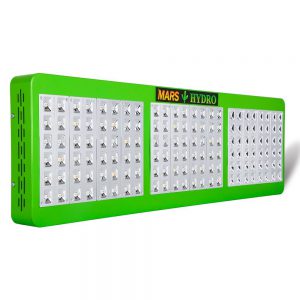 A slightly bigger version of the 96 but still well suited to grow tents and smaller to medium size projects. For 3 to 6 plants, the 144 produces 298 watts covering a 2 by 4-foot area. The 144 individual LED lights are angled at 90- 120 degrees to provide good penetration beneath the canopy. Like it’s smaller brother the MarsHydro Reflector 144 is outstanding value for money, boasting a 50,000-hour lifespan.
A slightly bigger version of the 96 but still well suited to grow tents and smaller to medium size projects. For 3 to 6 plants, the 144 produces 298 watts covering a 2 by 4-foot area. The 144 individual LED lights are angled at 90- 120 degrees to provide good penetration beneath the canopy. Like it’s smaller brother the MarsHydro Reflector 144 is outstanding value for money, boasting a 50,000-hour lifespan.
Read our in-depth Marshydro Reflector 720W LED Grow Light Review
2.11. MarsHydro Reflector 480W LED Grow Light
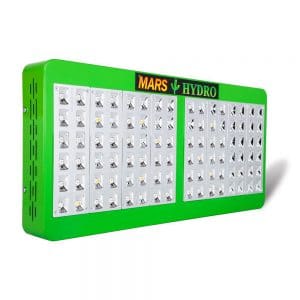 MarsHydro offers value for money and some really cool features. The MarsHydro has a built light reflector combined with a two-way switch for the vegetative and bloom stages. It offers a 50,000-hour lifespan which equates to 3 years constant growing. What I like about the MarsHydro is they do a lot of the work for you so you won’t have to invest in extra’s, like cooling fans, or red band lights. Suited to small grow projects of 2 to 4 plants with a coverage area of 3.5 by 2 foot in the veg stage and 3.5 by 1.5 foot in the bloom.
MarsHydro offers value for money and some really cool features. The MarsHydro has a built light reflector combined with a two-way switch for the vegetative and bloom stages. It offers a 50,000-hour lifespan which equates to 3 years constant growing. What I like about the MarsHydro is they do a lot of the work for you so you won’t have to invest in extra’s, like cooling fans, or red band lights. Suited to small grow projects of 2 to 4 plants with a coverage area of 3.5 by 2 foot in the veg stage and 3.5 by 1.5 foot in the bloom.
Read our in-depth Marshydro Reflector 480W LED Grow Light Review
2.12. VIPARSPECTRA 1200W LED Grow Light
 The Viparspectra 1200W LED Grow light is designed to replace traditional 1000W HPS system. It only consumes 524 Watts making it a highly efficient piece of equipment. With larger LEDs cooling can be an issue so I like how Viparspectra have included a 4.72-inch fan with an aluminum cooling heat sink.
The Viparspectra 1200W LED Grow light is designed to replace traditional 1000W HPS system. It only consumes 524 Watts making it a highly efficient piece of equipment. With larger LEDs cooling can be an issue so I like how Viparspectra have included a 4.72-inch fan with an aluminum cooling heat sink.
The Viparspectra also offers an outstanding lifespan of 100,000 hours so you won’t need to replace this grow light anytime soon. The maximum coverage is 5 by 5 foot which is suitable for larger scale projects where you’re looking to grow more than 20 plants at a time.
Read our in-depth VIPARSPECTRA 1200W LED Grow Light Review
2.13. VIPARSPECTRA Reflector-Series 600W LED Grow Light
 A slightly less powerful LED grow light with a maximum coverage of 4 by 4 foot. Viparspectra offer some of the most efficient grow lights and the 600W Reflector consumes an astonishingly low 276 Watts. What amazes me about that is usually as lights get smaller the efficiency suffers. The 600W LED offers almost the same efficiency ratio as it’s 1200W counterpart whilst retaining a 100,000-hour lifespan. It is great for medium sized projects of 8 to 12 plants, although, a little too big for a grow tent.
A slightly less powerful LED grow light with a maximum coverage of 4 by 4 foot. Viparspectra offer some of the most efficient grow lights and the 600W Reflector consumes an astonishingly low 276 Watts. What amazes me about that is usually as lights get smaller the efficiency suffers. The 600W LED offers almost the same efficiency ratio as it’s 1200W counterpart whilst retaining a 100,000-hour lifespan. It is great for medium sized projects of 8 to 12 plants, although, a little too big for a grow tent.
Read our in-depth VIPARSPECTRA Reflector-Series 600W LED Grow Light Review
2.14. VIPARSPECTRA Reflector-Series 450W LED Grow Light
 A surprisingly low price for a product with all the features of its more powerful counterparts. A maximum coverage of 3.5 by 3.5 foot is excellent given it only consumes 200 Watts. My only criticism of this range is that the full spectrum light doesn’t offer a switch between growth stages which means you may have to reposition the lights manually for the best results. Aside from that, it has a 100,000 hour making the Reflector Series 450W a shrewd option for smaller grow tents. It has no problem providing light for 4 to 6 plants.
A surprisingly low price for a product with all the features of its more powerful counterparts. A maximum coverage of 3.5 by 3.5 foot is excellent given it only consumes 200 Watts. My only criticism of this range is that the full spectrum light doesn’t offer a switch between growth stages which means you may have to reposition the lights manually for the best results. Aside from that, it has a 100,000 hour making the Reflector Series 450W a shrewd option for smaller grow tents. It has no problem providing light for 4 to 6 plants.
Read our in-depth VIPARSPECTRA Reflector-Series 450W LED Grow Light Review
2.15. VIPARSPECTRA PAR600 12-band LED Grow Light
 Offering a similar power output of 600W, and a similar lifespan of 100,000 hours, you might be wondering why the PAR600 is more expensive than the Reflector series equivalent. The reason is that they Viparspectra team have added some really cool features to the PAR600. The first is the three-way switcher for seed, vegetative and flower stage. The switcher optimizes light bands and intensity to maximize your yield.
Offering a similar power output of 600W, and a similar lifespan of 100,000 hours, you might be wondering why the PAR600 is more expensive than the Reflector series equivalent. The reason is that they Viparspectra team have added some really cool features to the PAR600. The first is the three-way switcher for seed, vegetative and flower stage. The switcher optimizes light bands and intensity to maximize your yield.
The second feature is an upgraded fan to keep it cool. Most LED’s only offer a two-way switch if that, making the PAR600 one of the most versatile grow lights on our list. If you’re starting out on a medium sized project, but want a maximum yield of 8 or more plants the PAR 600 is your best bet.
Read our in-depth VIPARSPECTRA PAR600 600W 12-band LED Grow Light Review
3. Why choose full spectrum LED grow lights?
Easy to set-up
When it comes to growing cannabis, you have to be aware that certain equipment is dependent on other equipment. You cannot run a 750W HID, for example, without a tall grow space and a ventilation exhaust. The issue, for first-time growers, is that the amount of equipment you need can easily spiral out of control along with the costs.
LED grow lights offer an all in one package. They produce very little heat and usually are fitted with an internal cooling system. LED’s also offer a full spectrum light source, meaning you won’t need to adjust your lighting during the process. In fact, the only thing you need to consider when using an LED is if you have a tall enough growing space. Smaller LED’s need to be 18 inches above your plants during the flowering stage. If you opt for a larger LED source, you would need to place it 30 inches above your plants to avoid light burning your bud.
Strong Light Source
As I mentioned above LED grow lights offer a powerful, penetrative light source but use little electricity. This is a massive benefit because once your plants reach the flowering stage you won’t have to worry about moving them to a more powerful light source. Furthermore, LED’s offer full spectrum light. Full spectrum light is the same as you would get from a natural light source. This is ideal for growing because when your crops reach the flowering stage you need yellow light to really get the most out of your yield. Using a LED grow light means you won’t have to worry about switching light sources during different stages of growth.
A decent yield with minimal effort
The success, or failure, of your home grow project is going to depend on your yield. A good way to think about cost, in terms of your light source, is by measuring the amount of bud you produce per watt of electricity; essentially this is your profit margin. LED’s don’t produce the highest yields but you can expect a decent return of around 0.5 grams per watt. That’s much higher than fluorescent light sources (0.25 per watt) but slightly below HPS, or HID lights. I guess what makes LED grow lights stand out is that they provide a good yield with the minimum amount of effort. All you have to do is plug it in the wall, and it’s ready to go, capable of providing light for the whole grow cycle.
A good light coverage
What I like the most about using LED grow lights is the light coverage per watt. Of course, this will be dependent on the kind of LED you get but, as a rule of thumb, we can say that LED’s coverage area is 32 watts to cover 1 square foot. This is more economical than HID’s which, in a 4 by 4-foot space, will use 62.5 watts per square foot. LED’s are 38% more efficient than HID’s which is not accounting for other factors like ventilation systems. We could estimate, when accounting for those other factors, that an LED is going to be over 50% more efficient in electricity usage than a HID. That’s a serious gain and a contributing factor to the rising popularity of LED grow lights in crop cultivation today.
Ideal for small scale production
When we take into account all of the above, what makes LED grow lights so popular is their ease of use. There are no hidden costs or extra equipment needed to use on a mid-range LED light. If you’re going for a very high wattage you may need to think about ways to filter out the heat but here, we’re talking about much larger grow projects. For a small home growing operation, say an ounce a month, LED’s will be your best option. For that, you get minimal fuss, minimal maintenance and a good yield.
4. Recommendations for choosing the best LED grow light
Grow Space
This is the single most important thing when choosing the light source. You’ll have to think about whether you have enough room for an LED. You need a grow space with at least 18 inches of room to fit your LED. If you’re looking at a bigger project, with a bigger LED, then you’re going to need at least 30 inches’ headroom.
Light
If you’re investing in a LED, make certain that it offers a full spectrum light source. Some of the older, and cheaper, models will only offer red or blue light. This is not good for growing. To grow your crops in the flowering stage you need green, yellow or white light to encourage photosynthesis. This is an absolute necessity for a good crop
Value
When you purchase anything you should always consider value. It might be tempting to find the cheapest lights available or opt for a second-hand light source but there are no guarantees when taking that path. When I’m considering a light source I think of it as an investment. A high-quality light source will last a long time. The same cannot be said for a cheaper option. Equally, a second-hand light source may be faulty or poorly produced. Think about your initial outlay in terms of years of use rather than price. A poor quality light source can easily lead to more outlays in repairs or upgrades further down the line.
Specifications
We’re going to cover this in more detail when we look at the 15 best LED grow lights in 2022 but, for now, let’s quickly run over what we’re looking for. The first is full spectrum light. After that, we want to consider the wattage, the price, grow stages and light coverage. All the lights we’re reviewing here offer a lifespan of between 50,000 to 100,000 hours. Special features will be mentioned on a product by product basis.
So far we’ve covered the advantages of an LED grow light and what to look for when choosing the best one for you. Now, we’re going to look at some of the best products available on the market, so you can have your pick.
5. Other equipment you might need
Ventilation
If you’re opting for a large project using a 1200W LED it’s likely that you’ll need some ventilation. Getting the heat wrong can really mess with your yield so, with larger lights, you’ll need to find a way to reduce that heat.
Grow Tents
Grow tents are a great little way to control the climate of your grow space. It’s also a necessity if you’re going to be using hydroponic systems alongside your lighting.
Thermometer and Hygrometer
These two products are very important if you want to get the most from your seeds. One lets you keep an eye on the temperature, the other measures humidity and gases. Cannabis plants need more than just light. Lots of nitrogen, the right temperate climate and humidity are going to do wonders for your yield.
Light Meter
Too little or too much light will wreak havoc with your crops. A light meter is a simple but effective way to make sure that doesn’t happen.
Hydroponics
Hydroponic systems are a way of providing plants with nutrients, minerals, and water without using soil. The advantage of hydroponics is that they can be programmed reducing the need for manual maintenance. The downside is that they are expensive. For large projects, hydroponics might be worth considering.
Grow room glasses
Full spectrum lighting comes with infrared and UV bands which can be harmful to the naked eye. If you’re going to be spending a lot of time in your grow room, a pair of protective glasses is a must.
Fertilizer and Soils
No matter how good your lights are, a healthy plant needs the right nutrients. Healthy plants give good yields so make sure you give them that by investing in the right fertilizers and soils.
6. LED Grow Lights Beginner Q&A
6.1. How much room will I need for a LED grow light?
The amount of room you need is going to depend on two factors: the coverage of your LED and the head-height in your grow space. Broadly speaking, an LED below 500W is going to be suitable for a grow tent or small scale operation. Just be aware that LED’s are powerful, so position your grow light at least 18 inches above your crop to avoid light burning. If it’s larger grow light, 600W+ you’re going to need to position it 30 inches above your crop. Measure the dimensions of your grow space to avoid making a costly mistake.
6.2. Some lights produce too much heat; will I need an extractor?
The big advantage of LED technology is they produce far less excess heat than traditional bulbs like HID’s. Most modern LED grow lights will also have inbuilt cooling systems as well that help to extract excess heat. Having said that, the largest lights will still produce a lot of heat, it’s just not possible to run a 1200W output without generating heat. Excess heat can mess with temperate climate in your grow space, or worse, burn your crops. If you’re undertaking a large project using a 1200W LED you’ll likely need an extractor fan as well.
6.3. How long does a LED grow light last for?
LED’s decay at a far lower rate than other types of lighting. For this reason, companies are promising astoundingly long lifespans for their products. We are talking between 50,000 and 100,000 hours. This, of course, doesn’t cover accidental damage or other system malfunctions. Suffice it to say, that as long as you take good care of your grow light, there’s no reason that it can’t last for 5 to 10 years; longer if you’re switching it off between sessions.
6.4. What’s the difference between the vegetative and flowering stages?
The vegetative stage is when the plant is growing but has yet to produce any noticeable buds. In this stage, you need less power meaning you can position your lights closer to the product. The flowering stage is when the plants begin to produce buds. During the flowering, or bloom, stage cannabis plants are photosynthesizing which means they need lots of full spectrum light. This includes UV and Infrared light. At this point you will want more powerful, penetrative light to pierce the canopies and maximize your yield. The differences in the types of light plants need in these two stages has led to many companies offering a switch between veg and bloom stages.
6.5. I’m new to growing what should I go for?
In my opinion, if this is your first time growing, you should opt for a small light, below 400W. The reason is that you need to experiment a little bit with smaller crop sizes before trying out bigger projects. A 1200W LED is going to cost a lot of money as well as increasing your electric bill by a significant amount. Start small, then gradually upgrade your equipment as your expertise grows.
